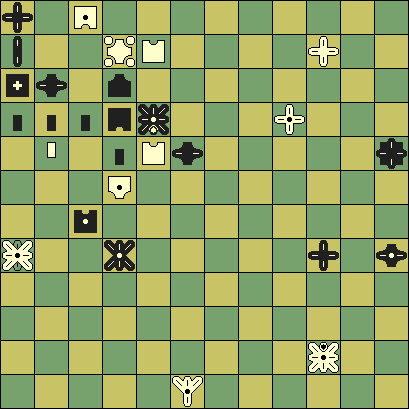
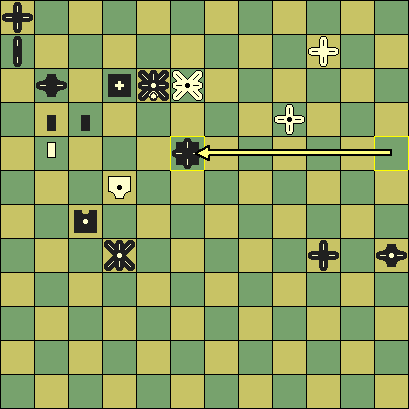
After 9... SMx7e
The promotion rules of Chu Shogi are controversial, as the Middle Shogi Manual, the English Wikipedia and the website of the Japanese Chu-Shogi renmei (CSRM) all mention different rules. All agree that captures that in any way touch the promotion zone (i.e. enter it, leave it, or are entirely contained in it) can always promote. But for non-captures the CSRM rules are the most restrictive: these can only promote a piece when they enter the zone. Promotion is always optional, and when a piece chooses to defer, it cannot promote on a later non-capture before it leaves the zone first. With the other two rule sets, the promotability on non-captures can be regained without any need for leaving the zone. In the MSM this can be done by moving the piece (a forced deferral if it is a non-capture). In the Wikipedia the promotability returns automatically after a one-turn delay.
So Wikipedia and MSM have promotability of in-zone pieces as an extra game-state variable, not implied by the board position. This makes the historic mating problems, which never mention anything about this state, ambiguous. The Wikipedia rules are the most liberal, and only cause doubts in case the first move of the solution needs to promote an in-zone piece on a non-capture. After any other move the promotability of any piece would have been regenerated. Not so under the MSM rules, though. There regaining promotability on non-capture needs an explicit move with the piece, while any move that defers in principle could also suspend the promotability again, in cases where it already existed. So one can hardly ever be sure about promotability of in-zone pieces under MSM rules, and the ambiguity of the game state will last deep into the problem, even for pieces that have already moved. (Unless they defer on a capture, as the capture would always have allowed them to promote, and deferring will thus suspend their right to do so on their next move.)
Solutions of mating problems under MSM rules are thus dependent not only on assumption of these rules, but also on an assumed initial state of the promotability of in-zone pieces. Even stepping pieces that deeply penetrated the zone are not guaranteed to be promotable, as their previous move could have been a capture. This makes MSM rules rather difficult to violate in a mating problem; it is always possible to adapt the assumption on the initial promotability so that any piece can be promoted on noncaptures as suits us. The only way to exclude that the MSM rules applied, would be when a solution needs a deferral on capture followed by promotion on non-capture. And none of the 224 historic mating problems given in the MSM has that.
So evidence against the MSM rules can only be circumstantial. One such circumstance is that none of the problems, not a single one, uses the method of moving a piece with suspended promotion rights as a method to 'revive' those rights, which is the distinguishing trait of MSM rule. When in-zone pieces eventually promote, they are always made to do so by providing a capture victim for them.
It is only possible to draw a conclusion on basis of a solution that was intended by the designer. Tsume problems fortunately have a convention that can be used to objectively judge this: every piece is supposed to have a function. A solution where sente would have 'spectator pieces', which could be deleted from the position without invalidating the solution, is an extremely strong indication that this solution is not what the designer had in mind. Likely he overlooked a variation where sente deviated with a stronger move, achieving the mate faster. We therefore introduce the qualification of solutions as 'intended' or 'unintended', depending on the presence of such spectator pieces. We also introduce a more subjective criterion based on elegance: An intended solution will not be referred to as 'intended', but merely as 'OK', when it looks less elegant than another intended solution. E.g. because it is embarrasingly shallow, leaves more pieces on the board in the mate position, etc.
All problems in the MSM that involved promotion were solved under CSRM rules (by setting the 'Promote on entry' option of HaChu), as well as more liberal rules (actually Wikipedia rule, but MSM rule together with favorable assumption on initial promotability can always achieve the same) that allowed promotion on non-captures inside the zone or leaving it. When a forced mate was found, it was qualified as 'intended', 'unintended' or 'OK'. Otherwise the problem was labeled 'impossible' (under the applied rules). The following table reports the results (DTM = distance to mate, in full moves):
|
MSM
problem | CSRM rule | in-zone non-capture promotions | remarks | ||
|---|---|---|---|---|---|
| DTM | type | DTM | type | ||
| B9 | 12 | intended & given | 7 | OK | lure victim to FL promo-square |
| B27 | 7 | intended & given | 5 | unintended | defer Ky promotion until captures |
| B31 | 8 | intended & given | 7 | unintended | lures victim to SM promo-square |
| B33 | 5 | intended & given | 4 | unintended | lures victim to SM promo-square |
| C11 | - | impossible (*) | 5 | unintended | *) An intended mate in 6 is flawed, as better defense exists |
| C21 | - | impossible (*) | 7 | intended | *) A flawed intended mate in 6 exists |
| C31 | 15 | intended | 9 | unintended | lures victim to S promo-square |
| C37 | 12 | intended | 7 | unintended | lures victim to Ph promo-square |
| D1 | - | impossible | ? | unsolved (*) | *) HaChu cannot find a mate even after days of searching |
| D6 | 13 | intended | 10 | unintended | lures victim to G promo-square |
| D7 | 15 | intended | 4 | unintended | refrains from promoting GB |
| D9 | 12 | intended | 5 | unintended | delays promoting GB until capture |
| D25 | - | impossible (*) | 12 | intended | *) intended mate in 12 can be refuted by emptying promo square |
| D32 | 13 | intended | 10 | unintended | refrains from promoting GB |
| D45 | - | impossible (*) | 5 | unintended | *) intended mate in 10 possible by FB->FK substitution |
| D63 | 8 | unintended (*) | 4/5 | unintended | *) less embarrasingly simple, but still many spectator pieces |
| D79 | 10 | intended | 7 | OK | lures victim to SM promo-square. MSM gives a solution in 15 |
| D84 | 11 | intended | 5 | unintended | lures victim to Ph promo-square |
| D86 | 8 | unintended (*) | 4 | unintended | *) this seems a flawed intended mate in 12 |
An overwhelming majority of the problems has the intended solution only under CSRM rule, and more relaxed promotion rules spoils them. Only in two cases (C21 and D25) an intended solution seems to need more relaxed promotion rules. One can argue that a single case where CSRM rules make the problem impossible to solve is more damaging evidence against the CSRM case, than the presence of some superfluous pieces are towards more relaxed promotion rules, so that mere counting of ayes and nayes is not good enough. We should always keep in mind, however, that we expect some problems to be unsolvable even under the intended rules. There are plenty of examples of this amongst the historic problems that do not involve promotions, where wrong understanding of the rules cannot be used as an excuse.
For this reason we scrutinize the cases where CSRM rule is not able to produce an intended solution, in order to see if a design flaw can be blamed for this. In particular, we check whether a sequence of moves exists that could be an intended solution, were it not that there exists a single refutation that the designer could have overlooked. As we will see below, this is usually the case.
C11 - This problem is already commented on in the MSM preface to the mating problems. There is a line using all pieces, even praised as 'superb' in the MSM. But an alternative defense to the key move refutes the mate alltogether. Under relaxed promotion rules the Eagle used to lure a capture victim to a square where a Leopard should promote in the intended line, would have no function at all under relaxed promotion rule, and can be deleted from the problem without altering the mate in 5 that exists when the Leopard can also promote on an empty square.
D1 - This problem seems flawed under any rule. For CSRM rule HaChu could prove there does not exist a solution. When the Kylin is allowed to promote on its first move (despite the fact that there is no need for it to have moved since its initial deferral), the situation is less clear. There are lines that just go on and on, by chasing a King in the open with a DK, B and +RC on a board with still many defenders. (After 1. +DH-2h Px2h 2. Rx6c+ Lnx6c 3. Ky-5c+ Lnx!5c 4. +SMx5c +SMx5c 5. +DK-5a SM-5b 6. +DKx5b K-5d 7. +RC-5j.) They don't seem to lead anywhere.
D25 - There is a mate in 12 here, which at first glance seems to be valid under CSRM rules, as its main line promotes the in-zone Phoenix on a capture.

1. BT-11e Kx11e (1... FKx11e 2. +Rx12h FK-12f 3. +Rx12f Kx12f 4. Lnx9i-10h K-12e 5. Ln-12g K-12d 6. Ph-10b= K-12c 7. Bx11b+ mate) 2. VMx10e= BTx10e (3... Gx10e 4. Rx10e BTx10e 5. Ln-10g K-10d 6. Lnx10e mate) 3. Ln-9g +Gx9g 4. Phx10f+ Phx10f 5. DKx12d+ Phx12d 6. Rx10e K-11d 7. +SM-12c FLx12c 8. Bx12c+ Kx12c 9. R-10c+ K-12b 10. +Rx12d K-11a 11. +R12d-11c K-12a 12. +R10c-11b mate.
There is an alternative defense, however, which would be very sub-optimal (4... Gx9g 5. Rx10e K-11d 6. R-10d+ Kx10d 7. Ph-9g+ mate) if the Phoenix could promote on a non-capture. This evacuates the intended promotion square, after which there is no mate under CSRM rules.
Under MSM rule there would only be a mate when one also assumes favorable initial promotability of the Phoenix, so it could promote on its first move. This despite the fact that the Phoenix is not so deep in the zone that it suggests it must already have made additional moves since its initial deferral.
It seems not too far-fetched here that the existence of this refuting variation is simply an oversight of the designer, as the intended main line does conform to CSRM rule.
D45 - The mate-in-5 solution given in the MSM is embarrasingly simple, and leaves many of the pieces without function. Intended line is probably:

|

After 9... SMx7e |
1. +GB-11b Kx11b 2. Ph-10b= K-12c 3. Phx12d= K-11b 4. Ph-10b= Kx10b (4... K-12c 5. +L-12f mate, or 4... K-11a 5. +G-4a +DH-5a 6. +Gx5a Kx10b 7. BT-9a= K-10c 8. R-10b= mate) 5. BTx9c+ Kx9c (5... K-11a 6. +G-4a +DH-8a 7. +Gx8a mate) 6. +DHx9e +DHx9e (6... K-10c 7. BTx9d +DHx9d 8. +DHx9d mate, or 6... K-8c 7. +DHx9d BTx9d 8. FKx9d mate) 7. BTx9d +DHx9d 8. +SM-7c +DH-8c 9. +Lx7e SMx7e,
but there it fizzles out. If the +SM would have been a FK, sente could continue with 10. FKx7e +DH-8d 11. FKx8d K-10c 12. FKx10d mate. But in that case the cute manoeuvre to remove P12d would be lost, because gote cannot afford 2... K-12c due to an immediate 3. FKx13 mate. This means gote would be forced to take Ph10b immediately, on the 2nd in stead of the 4th move, so that it would be a mate in 10, rather than in 12.This would not taint the solution by creating unused pieces, however. So an alternative explanation could be that this problem was corrupted by faulty copying, and that a Free Boar got somehow substituted for a Free King. Which differ only a single kanji in their name.
To preserve the full mate-in-12 solution the FK would have to be blocked from reaching 12d, e.g. by giving gote a Copper on 12g. (So that the White Horse can still move there when the King tries to escape through 3... Kx12d.) Or even better, by replacing it with a DH, which would not reach to 12d, and would promote on 7c to HF, capable of the same things as needed from the FK. But this of course goes beyond judging the quality of the existing evidence.
C21 - This seems to be the only case where there are no mitigating circumstances to explain away the absence of a solution under CSRM rule. The mate-in-7 solution promotes the in-zone Leopard on its first move, a non-capture leaving the zone: 1. DH-7d+ K-8b 2. +DHx!7c K-9c 3. FK-6f K-7b 4. FL-5e+ +L-6d 5. +FLx6d R-7c 6. DHx!6d +DK-6d 7. DH-9b mate.
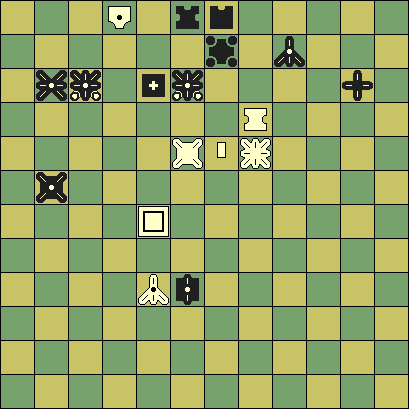
Perhaps the intended solution is: 1... +BTx7d 2. Ln-7e K-7b 3. FL-6c= +DKx6c 4. FK-7c +BTx7c 5. Ln-9c +DKx9c 6. +RC-8a mate, which does not need to promote the FL at all, but almost any other defense on the first move flaws this line.
Adding a gote Pawn on 4e, to provide a promotion opportunity for the FL, would fix the problem to a mate in 7 even under CSRM rules.
D63 - When the in-zone Phoenix can promote immediately, there is an embarrasingly simple mate in 4 for this problem. It leaves almost all pieces irrelevant. Wikipedia rule is not much better: 1. +Gx10c Kx10c 2. Ph-7c+ +BTx7c 3. DH-10a+ K-11d 4. +DHx10d K-12e 6. +DH-11e mate In fact the pieces seem to be lined up for driving the King along the 'escalator' formed by the gote pieces along the 12f-6l diagonal plus the sente Pawn on 11h (by repeated checking with a diagonally protected DK-or-better from the 12c-3l diagonal), towards the waiting Lion, which can then finish the job. But so far no sequence of moves (flawed or not) could be conceived to initiate such a drive.

Under CSRM rule there is a somewhat less simple mate in 8 (also given in the MSM), immediately sacrificing the Phoenix rather than attempting to promote it, through 1. Ph-9b GBx9b 2. +Gx10c Rx10c 3. +P-11b Kx11b 4. DHx9b+ R-10b 5. +VM-8e K-11a 6. +DH-9a Kx12b 7. +DHx10b Hx10b 8. DHx10b+ mate. This still leaves sente's Ln, +FL and G, not to mention all gote pieces in the lower board half, totally without function. So it seems we are overlooking something, and without identifying an interesting line that could have been the intended solution, this problem can hardly be used as evidence for anything. But it is hard to imagine that immediate promotion to a checking FK as appears in the mate-in-4 solution, could be something that was overlooked by the designer.
D86 - Again the MSM gives an embarrasingly simple mate-in-4 solution, which promotes a SM on an in-zone move and leaves most pieces without function. And again, the longer mate-in-8 that exists under CSRM rule (1. +B-11g +FLx11g 2. Kyx12i K-11i 3. +G-10i K-12j 4. Ky-12k K-11k 5. +G-10k K-12l 6. Ky-11j +RC-12c 7. +Rx12c +FL-12f 8. +Rx12f mate) does not satisfactorily solve that, as the pieces in the 2/3-file still do not participate in this.
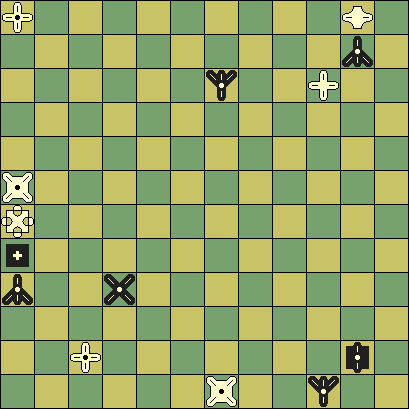
|
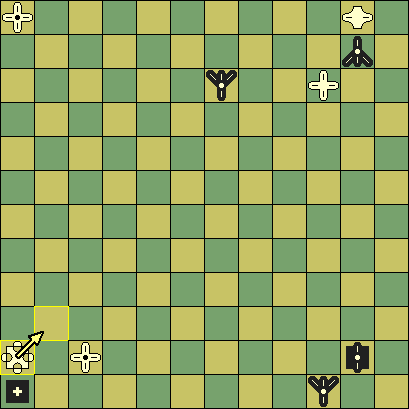
Could Ky-11j have been overlooked by the designer, so that he thought R3c has to be invoked here? |
We speculate that the designer overlooked the discovered check Ky-11j, which is the mating move apart from some futile interpositions. Arbitrarily forbidding this move, the solution becomes: 1. +B-11g +FLx11g 2. +Bx11g {to clear away the +B from the l-rank} Kx11g 3. +Gx10g K-12h {forced the King back, to pick up old solution} 4. Kyx12i K-11i 5. +G-10i K-12j 6. Ky-12k K-11k 7. +G-10k K-12l 8. Rx3l +BTx3l 9. SMx2b+ mate {ignoring 3 futile interpositions}. This way, each piece plays a role. It is not easy to repair the problem such that the 'parasitic' mate-in-8 would become impossible, and the intended line becomes the true solution, though.
When we accept this explanation, the problem, which otherwise would favor the CSRM rule only through having a somewhat less obvious solution under those, could be said to strongly favor CSRM rule: there does not seem any simple oversight that would require involvement of all pieces when the SM in-zone promotion is assumed to be allowed.
Evidence for the MSM rule that promotability of a piece after deferral can be revived by making a move with that piece (and then revoked again on a subsequent deferral) is conspicuously absent from the historic mating problems. There is not a single case where this method to regain promotability is used in a solution, be it intended or parasitic, or any of its sub-optimal-defense variations. The MSM solution to D79 uses this method, but it is not a historic one, and constructed in recent times under the assumption that MSM rule was valid. And even then it is obviously flawed, because a five-moves-faster solution exists even under CSRM rule (which would also work under the more liberal MSM rule). Wikipedia rules fare somewhat better in this respect, as many of the parasitic solutions take one turn before promoting the in-zone pieces.
So what inspired the thought that promotability on non-captures could be revived by other methods than leaving the zone? If it did not come from the mating problems, it must have come directly from the rule descriptions in the historic documents. On this, the famous Shogi promotor Hidetchi posted the following remark on the 81squareuniverse.com forum, however:
| 'cannot promote on the next turn': This must be a wrong translation of the original rule. The original document means "the next moves", "subsequent moves", or something like that. I believe someone misunderstood it as "only the next move" and it became the primary source overseas. |
If the CSRM rule has always been in use, it makes it immediately clear why the historic rule descriptions specify an exception for Pawn promotions. Pawns are irreversible pieces that can never leave the zone once they entered it. Having them promote on last rank instead seems a logical alternative. One might wonder why no such rule is mentioned for the other irreversible piece, the Lance. For Lances, however, no such rule is needed, as there never can be any reason to defer promotion of a Lance: the White Horse it promotes to is fully upward-compatible with it. Superficially the same holds for Gold vs. Pawn, but in fact there can be reasons for not promoting a Pawn. Problem B15, for example, can only be solved by invoking a Pawn deferral. (Hint: this has to do with the Lion-capture rules.)
There only seems to be one problem (C21) that solidly resists solution without promoting a zone-leaving piece on a non-capture. Assuming the latter is possible spoils most of the other problems, by introducing a parasitic solution making use of this possibility. Only in a few other cases relaxed promotion rules cause appearance of a solution to an otherwise unsolvable problem. But this then almost always is a parasitic solution, leaving pieces without function, while a line exists under CSRM rules that looks like an intended solution, but is flawed with a plausible excuse. (Such as mutilation of the problem position by copying errors, or a plausible oversight of the designer.)